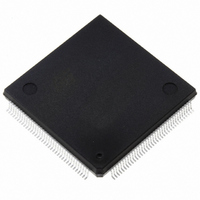ST10F269Z2Q6 STMicroelectronics, ST10F269Z2Q6 Datasheet - Page 52

ST10F269Z2Q6
Manufacturer Part Number
ST10F269Z2Q6
Description
MCU 16BIT 256K FLASH 144PQFP
Manufacturer
STMicroelectronics
Series
ST10r
Specifications of ST10F269Z2Q6
Core Processor
ST10
Core Size
16-Bit
Speed
40MHz
Connectivity
CAN, EBI/EMI, SSC, UART/USART
Peripherals
POR, PWM, WDT
Number Of I /o
111
Program Memory Size
256KB (256K x 8)
Program Memory Type
FLASH
Ram Size
12K x 8
Voltage - Supply (vcc/vdd)
4.5 V ~ 5.5 V
Data Converters
A/D 16x10b
Oscillator Type
Internal
Operating Temperature
-40°C ~ 85°C
Package / Case
144-QFP
Controller Family/series
ST10
No. Of I/o's
111
Ram Memory Size
12KB
Cpu Speed
40MHz
No. Of Timers
5
Embedded Interface Type
CAN, SSC, USART
Rohs Compliant
Yes
Processor Series
ST10F26x
Core
ST10
Data Bus Width
16 bit
Data Ram Size
12 KB
Interface Type
CAN, SSC, USART
Maximum Clock Frequency
40 MHz
Number Of Programmable I/os
111
Number Of Timers
2 x 16 bit
Operating Supply Voltage
0.3 V to 4 V
Maximum Operating Temperature
+ 85 C
Mounting Style
SMD/SMT
Minimum Operating Temperature
- 40 C
On-chip Adc
16 bit x 10 bit
Lead Free Status / RoHS Status
Lead free / RoHS Compliant
Eeprom Size
-
Lead Free Status / Rohs Status
Details
Other names
497-4833
Available stocks
Company
Part Number
Manufacturer
Quantity
Price
Company:
Part Number:
ST10F269Z2Q6
Manufacturer:
ST
Quantity:
201
Company:
Part Number:
ST10F269Z2Q6
Manufacturer:
ST
Quantity:
745
Company:
Part Number:
ST10F269Z2Q6
Manufacturer:
STMicroelectronics
Quantity:
10 000
Part Number:
ST10F269Z2Q6
Manufacturer:
ST
Quantity:
20 000
10 - GENERAL PURPOSE TIMER UNIT
10 - GENERAL PURPOSE TIMER UNIT
The GPT unit is a flexible multifunctional timer/
counter structure which is used for time related
tasks such as event timing and counting, pulse
width and duty cycle measurements, pulse
generation, or pulse multiplication. The GPT unit
contains five 16-bit timers organized into two
separate modules GPT1 and GPT2. Each timer in
each module may operate independently in
several different modes, or may be concatenated
with another timer of the same module.
10.1 - GPT1
Each of the three timers T2, T3, T4 of the GPT1
module can be configured individually for one of
four basic modes of operation: timer, gated timer,
counter
mode.
In timer mode, the input clock for a timer is derived
from the CPU clock, divided by a programmable
prescaler.
In counter mode, the timer is clocked in reference
to external events.
Pulse width or duty cycle measurement is
supported in gated timer mode where the
operation of a timer is controlled by the ‘gate’ level
on an external input pin. For these purposes, each
timer has one associated port pin (TxIN) which
serves as gate or clock input.
Table 12
Resolution and Periods (PQFP144 devices) and
Table 13
Resolution and Periods (TQFP144 devices) list
the timer input frequencies, resolution and periods
for each pre-scaler option at 40MHz (Table 12
GPT1 Timer Input Frequencies, Resolution and
Periods (PQFP144 devices)) or 32MHz (Table 13
GPT1 Timer Input Frequencies, Resolution and
Periods (TQFP144 devices)) CPU clock. This also
Table 12 : GPT1 Timer Input Frequencies, Resolution and Periods (PQFP144 devices)
52/184
Pre-scaler factor
Input Freq
Resolution
Period maximum
f
CPU
= 40MHz
mode and incremental interface
GPT1
GPT1
13.1ms
200ns
Timer
Timer
5MHz
000b
8
Input
Input
2.5MHz
26.2ms
400ns
001b
16
Frequencies,
Frequencies,
1.25MHz
52.4ms
0.8µs
010b
32
Timer Input Selection T2I / T3I / T4I
104.8ms
625kHz
1.6µs
011b
64
applies to the Gated Timer Mode of T3 and to the
auxiliary timers T2 and T4 in Timer and Gated
Timer Mode. The count direction (up/down) for
each timer is programmable by software or may
be altered dynamically by an external signal on a
port pin (TxEUD).
In Incremental Interface Mode, the GPT1 timers
(T2, T3, T4) can be directly connected to the
incremental position sensor signals A and B by
their respective inputs TxIN and TxEUD.
Direction and count signals are internally derived
from these two input signals so that the contents
of the respective timer Tx corresponds to the
sensor position. The third position sensor signal
TOP0 can be connected to an interrupt input.
Timer T3 has output toggle latches (TxOTL) which
changes state on each timer over flow / underflow.
The state of this latch may be output on port pins
(TxOUT) for time out monitoring of external
hardware components, or may be used internally
to clock timers T2 and T4 for high resolution of
long duration measurements.
In addition to their basic operating modes, timers
T2 and T4 may be configured as reload or capture
registers for timer T3. When used as capture or
reload registers, timers T2 and T4 are stopped.
The contents of timer T3 is captured into T2 or T4
in response to a signal at their associated input
pins (TxIN).
Timer T3 is reloaded with the contents of T2 or T4
triggered either by an external signal or by a
selectable state transition of its toggle latch
T3OTL. When both T2 and T4 are configured to
alternately reload T3 on opposite state transitions
of T3OTL with the low and high times of a PWM
signal, this signal can be constantly generated
without software intervention.
312.5kHz
209.7ms
3.2µs
100b
128
156.25kHz
419.4ms
6.4µs
101b
256
78.125kHz
838.9ms
12.8µs
110b
512
ST10F269
39.1kHz
25.6µs
1.678s
111b
1024













